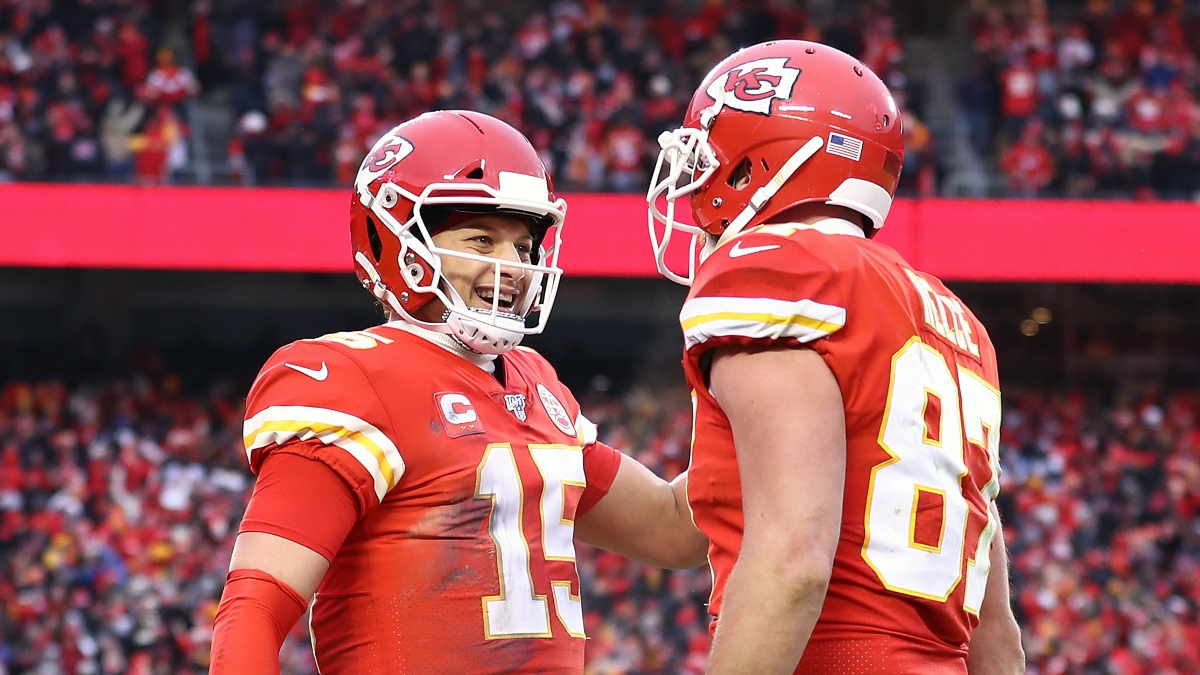Best Ball Rankings & Strategy: Draft Tiers For Every Position
Jamie Squire/Getty Images. Pictured: Patrick Mahomes, Travis Kelce
There's no in-season roster management in best ball — no waiver wire adds, no trades, nothing — so it all comes down to your draft.
Only the highest scores count each week, which means poor performances from a given player in a given week are less detrimental than they would be in re-draft leagues, where you have to set a lineup. But that also means we have to maximize our team's ceiling as much as possible. And in order to really do that, you have to make picks based on how a draft is unfolding and which players are available.
That's why it’s critical to use tiers rather than exact rankings when drafting in best ball.
Below I've outlined my overall strategy for drafting each position in best best, where you can find links to each set of tiers.
Best Ball Rankings & Strategy
QB Rankings & Strategy
Most seasons, streaming QBs off the waiver wire based on their week-to-week matchup can result in about a QB5-level of production for free. But best ball leagues are much different in that regard.
There is no waiver wire in best ball, so we have to take the position more seriously in drafts.
When it comes to draft strategy for QBs in best ball, I like to approach it with the mindset of an actual QB. Think of your RB and WR draft strategy as the play call in the huddle. This is the foundation for what you want to achieve in the draft.
Drafting QB and TE is more about reading what the defense — in this case, your league-mates — give you. Typically when I select either position, I'm thinking, "Well, I didn't want to take a QB/TE here, but since Player X is still available, I am going to pull the trigger."
That's why it's critical to use tiers rather than exact rankings when drafting in best ball.
RB Rankings & Strategy
Running back is emerging as the most critical position in fantasy football as the NFL becomes a more pass-heavy league and teams implement committees, making true workhorse RBs much more scarce.
That means landing one to two workhorse backs early in drafts is key.
But RB is also the most volatile position. Whether it's due to injuries or coaching decisions, the RB landscape changes the most in-season, and that sort of chaos also creates massive value later in drafts (and in-season with the waiver wire).
Except we don't have the luxury of dropping or adding players mid-season in best ball, therefore we need to maximize our leverage in drafts. I attempt to do this with very strategic roster construction: Target workhorse RBs in early rounds, then RBs who could potentially benefit from the chaos in later rounds.
Of course, every draft is different, so we need to adapt and let each one come to us.
With that in mind, I've ranked RBs into best ball tiers so you know which type of backs to prioritize taking and when, depending on how your draft is unfolding.
WR Rankings & Strategy
As is the case most seasons, the wide receiver position is loaded from top-to-bottom heading into 2020.
There are so many high-ceiling, high-floor players available in every single round that you'll have the flexibility to let the draft come to you knowing you'll have plenty of contingency plans if you miss out on a given tier of WRs.
Of course, it depends on your draft position, but I've found that Rounds 3-6 are the sweet spot for loading up at WR. That strategy allows you to snag two running backs and a top quarterback or tight end over the first three rounds — positions that have sharp drop-offs near the top, whereas WR has more of a gradual decline.
You also want to make sure you've drafted most of your WR depth by about Round 12.
Unlike RB, the WR position doesn't provide as much upside in the later rounds. For example, Jaguars RB Ryquell Armstead and Patriots WR N'Keal Harry are both going in Round 13 according to average draft position (ADP). Armstead has baked-in upside — if Leonard Fournette were to miss time, Armstead would become a solid RB2 — whereas Harry's value would rise if Julian Edelman were to miss time, but not nearly as much.
That's why you shouldn't take too many WR fliers at the end of the draft and instead load up on them from Rounds 3-12, if possible.
TE Rankings & Strategy
As the NFL becomes more pass-heavy, the tight end position is increasingly fantasy-friendly — now it's deeper than ever.
We'll still likely draft only one TE per team in re-draft leagues, meaning the waiver wire will be loaded. But without any in-season roster management in best ball, there is much more strategy involved in drafts, as most teams will be drafting two to three TEs.
Tier 7 of my TE rankings appears to be the sweet spot for me — it's the range George Kittle went in 2018 then Austin Hooper and Mark Andrews went in 2019. Every single one of this season's Tier 7 TEs has the potential to keep that trend going.
Taking a swing on two TEs between Rounds 8-11 would be a good game plan heading in. But as always, I let the draft come to me, so if there are TEs who are too good to pass up before that range, I will take them.
How would you rate this article?








